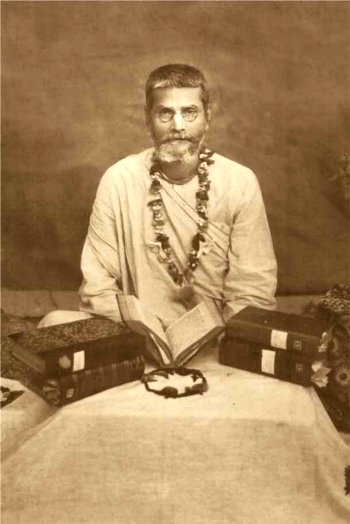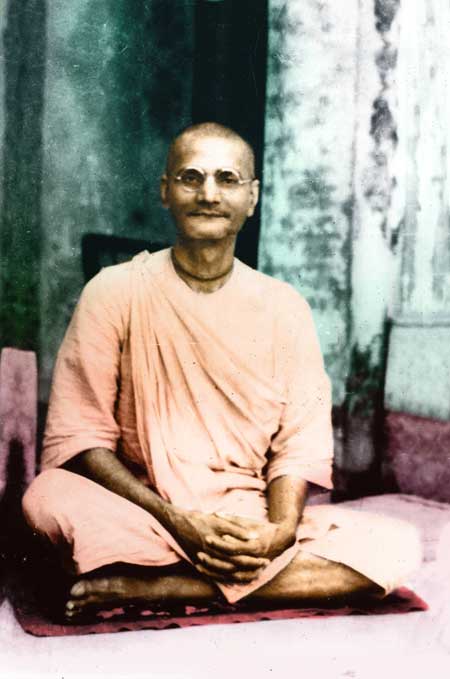śrī śrī guru gaurāṅga jayataḥ!

Year 10, Special Edition
Posted: 25 March 2017
Dedicated to
nitya-līlā praviṣṭa oṁ viṣṇupāda
Śrī Śrīmad Bhakti Prajñāna Keśava Gosvāmī Mahārāja
Inspired by and under the guidance of
nitya-līlā praviṣṭa oṁ viṣṇupāda
Śrī Śrīmad Bhaktivedānta Nārāyaṇa Gosvāmī Mahārāja
My Remarks

Preface to the book, Śrī Rūpānuga-bhajana-sampat [“The Wealth of Śrī Rūpānuga-bhajana”] by Śrī Śrīmad Bhakti-prajñāna Keśava Gosvāmī Mahārāja
The name of this book is Śrī Rūpānuga-bhajana-sampat. In reality, based on Śrīla Rūpa Gosvāmī’s Śrī Bhakti-rasāmṛta-sindhu and Śrī Ujjvala-Nīlamaṇi, Śrīla Bhaktivinoda Ṭhākura penned the essence of these books in concise poetry as a separate book called Śrī Rūpānuga-bhajana-darpaṇa. The exalted servitor followers of Śrīman Mahāprabhu aspire to be immersed in the śrī rūpānuga-dhārā, the current of conceptions following Śrīla Rūpa Gosvāmī. This is because while Śrīman Mahāprabhu was residing in Śrīdhāma Purī, upon hearing a śloka written by Śrīla Rūpa Gosvāmī, He asked, “How did Rūpa become aware of the confidential matters of My heart?” All the devotees present said to Śrīman Mahāprabhu, “Śrī Rūpa has understood all Your hidden moods solely by Your mercy.” Thus, because all the activities, behaviour and ideology of Śrīla Rūpa Gosvāmī is in accord with the desire of Śrīman Mahāprabhu, the Gauḍīyas feel pride in being a ‘rūpānuga’, or follower of Śrī Rūpa Gosvāmī. We have therefore published Śrīla Bhaktivinoda Ṭhākura’s poetic rendition of Śrīman Mahāprabhu’s Śrī Śikṣāṣṭaka at the very beginning of this book. Śrīman Mahāprabhu’s Śikṣāṣṭaka is indeed the sole bhajana-sampat, devotional wealth of the multitude of Mādhva-Gauḍīya-Vaiṣṇavas. Śrīla Rūpa Gosvāmī and the other Gosvāmīs have expanded on and elucidated this Śikṣāṣtaka in various books. It can be said that all the books of the Gosvāmīs are an exposition of Śikṣāṣṭaka.
Śrīla Ṭhākura Bhaktivinoda rendered the essence of the Gosvāmīs’ prayerful aṣṭakas, etc. in charming poetry and thus bestowed supreme good fortune and bliss on the rūpānuga-sādhakas and siddhas. All these renditions [of Śrīla Ṭhākura Bhaktivinoda] have been included in this bhajana-sampada. In this book eleven topics have been discussed. The reader can fathom the glory of this scripture by reading the table of contents. Śrī Nāma-bhajana-praṇālī (the methodology of nama-bhajana) and Śrī Nāma-māhātmya (the glory of the holy name) are presented at the beginning of this book. That is truly the śrī rupānuga-bhajana-sampat, the devotional treasure of the followers of Śrī Rūpa Gosvāmī. Through this, the position of the author, Śrīla Bhaktivinoda Ṭhākura, is recognized as being on a level equal to that of the Gauḍīya Gosvāmīs.
In the name of ‘rūpānuga-bhajana’, the ‘īcaḍe-pākā’ [those who pretend to be mature before being mature] sahajiyās, who have strayed from the path, accept only pārakīya madhura-rasa as bhajana. They have concluded that there is no other rasa such as dāsya, sakhya, vātsalya and so on within rūpānuga-bhajana. This indeed reveals the sahajiyā cult’s ignorance of rasa-tattva and its waywardness. Nowadays, many people in the sārasvata-bhaktivinoda-dhārā, or the line of thought of Śrīla Sarasvatī Ṭhākura and Śrīla Bhaktivinoda Ṭhākura, stray from the line of thought following Śrīla Rūpa Gosvāmī (rūpānuga-vicāra-dhārā), and licking the feet of the ‘īcaḍe-pākā’ sahajiyās, say, “What’s the use of preaching? What is there in performing kīrtana? Do bhajana, just do bhajana.” By saying “Do bhajana”, this class of heretic, instead of performing [genuine] śrī nāma-bhajana, use the chanting the holy name on beads as a pretext for considering only their deceptive pulling of rope on beads while sitting quietly, to be bhajana. The surprising thing is that they don’t even feel shame in practicing this in front of many people. Indeed, service in the form of glorifying Śrī Hari (hari-kirtana) is true rūpānuga-bhajana. Any other practice is not the practice of rūpānuga-bhajana.
Thus, propagating the teachings of Śrīman Mahāprabhu is true hari-kīrtana. ‘Śrī nāma-kīrtana’ is to be understood as the performance of the kīrtana of all aspects [of the Lord], such as the kīrtana of Lord’s name, form, qualities, pastimes, associates and specialities. Therefore, only those who are preachers have taken shelter of harināma; they are truly kīrtanīyas and thus performers of rūpānuga-bhajana. Those who do not propagate the kathā (message and teachings) of Śrīman Mahāprabhu, or do not help with its propagation, are fully ignorant of anything in regards to rūpānuga-bhajana. By discussing the life and activities of Śrīla Rūpa Gosvāmī, one can realize the truth of this matter. “Āpani ācari dharma jīvera śikhāya – teach dharma to the living entities by personally practicing dharma yourself.” This instruction of Śrīman Mahāprabhu is fully reflected in the life of Śrīla Rūpa Gosvāmī.
Many heretic brāhmaṇas – or in the judgement of Śrī Caitanya-bhāgavata, ‘rākṣasa-brāhmaṇas’ – consider the impeccably pure Vaiṣṇavas who stand up in opposition to the dharma-dhvajīs [those who wave the banner of religion but do not actually follow religion] who go against and destroy the unique preaching of Śrīman Mahāprabhu, to be kṣatriyas. They think that since Śrīman Mahāprabhu, following the line of thought of Śrī Madhvācarya, brought opponents [Māyāvādīs] into His own doctrine, this too was His kṣatriya nature. “Asinā tattvamasinā parajīva prabhedinā [– with the sword (asi) of tattva, the Vaiṣṇavas established that there is a difference between īśvara and the jīva and crushed the conception of the Māyāvādīs].” In statements such as these, by holding a ‘sword’, one’s brāhmaṇatā has been destroyed and one has become warrior-like [instead]. Considering weakness, laziness and inactivity in sevā to be Vaiṣṇavism, they want to be called ‘bhajanānandīs’. In truth, this is simply known as an effeminate nature. Many people of this class are seen to decorate themselves as ‘mañjarīs’ and [whimsically] accept their ‘ekādaśa-bhāvas’ such as their name, form, age, relationship, dress and ornaments, and remain immersed in thoughts of women voluntarily. It is seen that such people, themselves being male, constantly engage in illicit sex with their imaginary, conceptual female mañjarīs. This is one kind of mental sex. Such kinds of evil mentalities of theirs are gradually becoming manifested factually too in the external world. This is the greatest heresy and waywardness. This book, Śrī Rūpānuga-bhajana-sampat, will bring even this class of people to the path of truth and bring about their supreme welfare.
Written on Śrī Baladeva-āvirbhava-tithi, 29 August 1958
Translated from Śrī Gauḍīya-patrikā, Year 10, Issue 9
by the Rays of The Harmonist team
![]()









